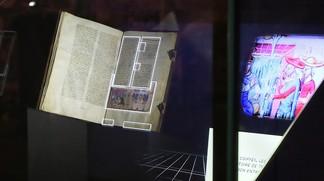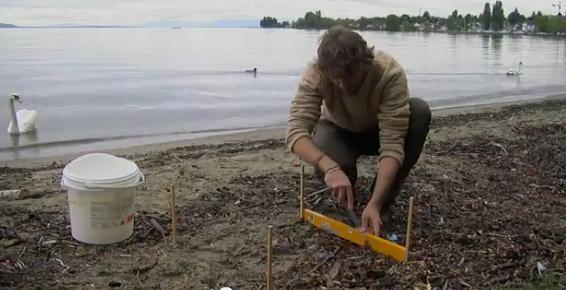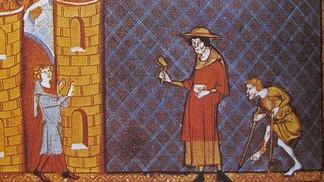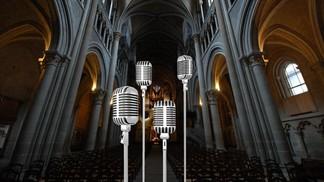Looking back at 2013 (2/3): When Genes Act Like History Books © Jamani Caillet (EPFL)
Ultra-fast running robots, genetic research that gives hints at medieval history, or soil studies to detect pollutants or anticipate landslides are a few of the remarkable findings of EPFL's last spring.
Nanowires Have the Power to Revolutionize Solar Energy 08.04.13 - Capture up to 12 times more light to produce more energy? Nanowires do just that and surpass expectations on solar energy production. Nanowires are extremely tiny filaments–in this case able to capture light–with a diameter that measures tens to hundreds of nanometers, where a nanometer is one millionth of a millimeter. These miniscule wires are up to 1000 times smaller than the diameter of human hair. When equipped with the right electronic properties, the nanowire becomes a tiny solar cell, transforming sunlight into electric current. Anna Fontcuberta i Morral and her team built a nanowire solar cell out of gallium arsenide, a material which is better at converting light into power than silicon. They found that it actually collects more light than the usual flat solar cell–up to 12 times more–and more light means more energy.
Predicting the unpredictable
A technological showcase brings manuscripts to life
Microplastic pollution prevalent in lakes too 31.05.13 - EPFL researchers have detected microplastic pollution in one of Western Europe’s largest lakes, Lake Geneva, in large enough quantities to raise concern. While studies in the ocean have shown that these small bits of plastic can be harmful to fish and birds that feed on plankton or other small waterborne organisms, the full extent of their consequences in lakes and rivers is only now being investigated. Microplastics in continental waters may be the main source of microplastic pollution in oceans, where huge hotspots containing high concentrations of these pollutants have formed. Scientists estimate that only around 20 percent of oceanic microplastics are dumped straight into the sea. The remaining 80 percent are estimated to originate from terrestrial sources, such as waste dumps, street litter, and sewage.
Unraveling the genetic mystery of medieval leprosy
14.06.13 Why was there a sudden drop in the incidence of leprosy at the end of the Middle Ages? To answer this question, biologists and archeologists reconstructed the genome of medieval strains of the pathogen responsible for the disease, which they exhumed from centuries old human graves. Their results, published in the journal "Science", shed light on this obscure historical period and introduce new methods for understanding epidemics. Reconstructing the bacterial genomes was no easy task, as the material available—from the human remains—contained less than 0.1% of bacterial DNA. The researchers developed an extremely sensitive method for separating the two kinds of DNA and for reconstituting the target genome with an unprecedented level of precision. “We were able to reconstruct the genome without using any contemporary strains as a basis,” explains study co-author and EPFL scientist Pushpendra Singh, who worked closely with Johannes Kraus and team from Tubingen University in Germany.
A robot that runs like a cat
17.06.13 Even though it doesn’t have a head, you can still tell what kind of animal it is: the robot is definitely modeled upon a cat. Developed by EPFL’s Biorobotics Laboratory (Biorob), the “cheetah-cub robot,” a small-size quadruped prototype robot, is described in an article in the International Journal of Robotics Research. The purpose of the platform is to encourage research in biomechanics; its particularity is the design of its legs, which make it very fast and stable. Robots developed from this concept could eventually be used in search and rescue missions or for exploration. This robot is the fastest in its category, namely in normalized speed for small quadruped robots under 30Kg. During tests, it demonstrated its ability to run nearly seven times its body length in one second. Although not as agile as a real cat, it still has excellent auto-stabilization characteristics when running at full speed or over a course that included disturbances such as small steps. In addition, the robot is extremely light, compact, and robust and can be easily assembled from materials that are inexpensive and readily available.
Mapping a room in a snap
18.06.13 Blind people sometimes develop the amazing ability to perceive the contours of the room they’re in based only on auditory information. Bats and dolphins use the same echolocation technique for navigating in their environment. At EPFL, a team from the Audiovisual Communications Laboratory (LCAV), under the direction of Professor Martin Vetterli, has developed a computer algorithm that can accomplish this from a sound that’s picked up by four microphones by comparing the signal from each microphone. The infinitesimal lags that appear in the signals are used to calculate not only the distance between the microphones, but also the distance from each microphone to the walls and the sound source. Their experiment was published in the Proceedings of the National Academy of Sciences (PNAS).


 17.04.13 - EPFL scientists have developed the first system to issue early-warning alerts for landslides. John Eichenberger, a PhD student in EPFL’s Soil Mechanics Laboratory, has spent four years under the direction of Professor Lyesse Laloui developing a tool that can reproduce the behavior of steep slopes when subject to heavy precipitation. Research was conducted in both the laboratory and the field, in particular on the slopes of the Rhine River, where he coupled sensors to a computer model. The model was able to accurately detect when the saturation state of the soil reached dangerous levels, thus allowing an early warning to be given.
17.04.13 - EPFL scientists have developed the first system to issue early-warning alerts for landslides. John Eichenberger, a PhD student in EPFL’s Soil Mechanics Laboratory, has spent four years under the direction of Professor Lyesse Laloui developing a tool that can reproduce the behavior of steep slopes when subject to heavy precipitation. Research was conducted in both the laboratory and the field, in particular on the slopes of the Rhine River, where he coupled sensors to a computer model. The model was able to accurately detect when the saturation state of the soil reached dangerous levels, thus allowing an early warning to be given.  26.04.13 - EPFL has conceived "holographic showcases" as part of its quest on the museum experiences of the future. Come to the window. Have a look at at the beautiful illuminations that enhance this 12th century manuscript, secured in its glass case. Suddenly, as if by magic, its margins become alive and new pieces of information seem to be coming out of the page, moving away from the text, adding a new dimension to it. "We are trying to create a new kind of museum language that is able to combine in a single space the museum experience together with its explanation, said Frédéric Kaplan, digital humanities professor at EPFL. Each showcase contains a 3D camera that allows us to analyze each visitor's behavior and her/his reactions to the changes in the windows' contents."
26.04.13 - EPFL has conceived "holographic showcases" as part of its quest on the museum experiences of the future. Come to the window. Have a look at at the beautiful illuminations that enhance this 12th century manuscript, secured in its glass case. Suddenly, as if by magic, its margins become alive and new pieces of information seem to be coming out of the page, moving away from the text, adding a new dimension to it. "We are trying to create a new kind of museum language that is able to combine in a single space the museum experience together with its explanation, said Frédéric Kaplan, digital humanities professor at EPFL. Each showcase contains a 3D camera that allows us to analyze each visitor's behavior and her/his reactions to the changes in the windows' contents."


